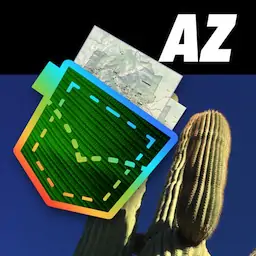Crystal Hill AreaKofa |
Crystal Hill Area in Kofa National Wildlife Refuge (NWR) in Arizona. Published by the U.S. Fish & Wildlife Service (USFWS).
featured in
| Arizona Pocket Maps |  |
U.S. Fish
U.S.
Fish&&Wildlife
Wildlife
Service
Service
Crystal Hill Area
Kofa National Wildlife Refuge
Crystal Hill, located in the northwest
corner of Kofa National Wildlife Refuge
in the Livingston Hills, is the only area
within the refuge where recreational rock
or mineral collecting is permitted. Quartz
crystals are hidden in the washes and on
the rocky slopes of Crystal Hill, making
this an ideal location for rockhounding
or collecting. While searching for quartz
crystals at the top of the hill, visitors can
also enjoy the 360 degree view of the
surrounding area.
Creation of the Mountains
The mountains of Kofa National Wildlife
Refuge, which rise abruptly from the flat
desert, are characteristic of the Basin
and Range Province which covers much
of the western United States and extends
into northwestern Mexico. In this
physiographic region, the Earth’s crust
and upper mantle thinned and cracked
as they were stretched and pulled apart.
Quartz Formation
Quartz, belonging to the class of silicates,
comprises approximately 12 percent of
the Earth’s crust. It is produced when
the two most abundant elements in the
surface of the Earth, oxygen and silicon,
bond. Quartz crystallizes when volcanic
magma cools and becomes solid.
A fault created by crustal movement.
Illustration from http://clasfaculty.ucdenver.edu/
callen/1202/Battle/Build/Faulting/Faulting.html
This crustal movement created faults
and eventually led to the creation of
mountains and valleys as the Earth’s
surface uplifted on the upthrown side
of the fault and down-dropped on the
lower side.
Over time, the block-faulted mountains
weathered and eroded. Volcanic episodes
also occurred within the refuge and thus
the mountain ranges of Kofa National
Wildlife Refuge contain old lava layers
and volcanic rocks, such as basalt,
volcanic tuff and obsidian.
Quartz appears in a variety of forms and
shapes and varies from being clear to
almost opaque. It may be found in the
form of large grains, crystals or veins.
Crystals can appear either as a single
point or in a cluster. Pure quartz is white
or colorless, while other types of quartz
may be rose, yellow, green, blue, violet,
brown, or black depending on the trace
elements they contain.
The Livingston Hills are known to have
both quartz veins and crystals. Some
veins in the hills contain tourmaline and
pyrite, two other minerals. Most of the
quartz crystals found at Crystal Hill are
either clear or milky white.
Rockhounding and Collecting on the
Refuge
When searching for quartz crystals on
the refuge, it is important to remember
that recreational (noncommercial) rock
or mineral collecting is not permitted
beyond the boundaries of the Crystal
Hill Area (see map). Collection of rocks
is limited to 10 specimens or 10 pounds
(whichever occurs first) in any 12-month
period. Rock or mineral collection is
limited to materials that are exposed
and collectable without the use of tools,
including metal detectors. Digging
is prohibited. Please see the Kofa
National Wildlife Refuge leaflet Public
Use and Hunting Regulations for more
information about regulations.
For Further Information
U.S. Fish and Wildlife Service
Kofa National Wildlife Refuge
9300 East 28th Street
Yuma, AZ 85365
928/783-7861
Monday–Friday: 8:00 a.m.–4:30 p.m.
February 2014
Front, illustration of a desert bighorn.
Illustration by Elizabeth Montgomery
Desert bighorn at Kofa National Wildlife
Refuge. / USFWS.

